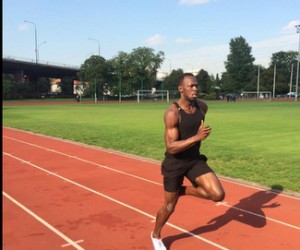
By NAN Staff Writer
News Americas, NEW YORK, NY, Weds. Nov. 19, 2014: Four university professors from around the globe teamed up with the president and co-founder of a Jamaican track club to decipher what they feel is the secret behind the success of Jamaica’s top sprinters.
Robert Trivers, an evolutionary biologist and professor of anthropology and biology in the School of Arts and Sciences, at Rutgers University, along with co-authors Bernhard Fink of the University of Gottingen in Germany; Kristofor McCarty and Mark Russell of Northumbria University in England; Brian Palaestis of Wagner College in Staten Island, New York; and Bruce James of the MVP Track and Field Club in Kingston, Jamaica, have published their findings in the journal PLOS ONE.
The professors, along with James, looked at the degree of lower body symmetry in 74 elite Jamaican track and field athletes. The sprinters were all members of the MVP Track and Field Club, and included Shelly Ann Fraser-Pryce, who holds two Olympic gold medals in the 100-meter sprint, and Nesta Carter, the man with the fifth fastest 100-meter runs ever recorded.
The professors had set out to find if there was something about the symmetry of the athletes’ knees that might partly explain the success of Jamaican athletes in sprints globally. They already knew from their earlier research that the symmetry of children’s knees at age 8 predicts how fast a person runs 14 years later in life.
“We then asked, ‘Is the degree of symmetry positively associated with sprinting ability among the very best sprinters?’” Trivers told Rutgers News.
The answer to that question is yes.
They found that both the knees and ankles of the top athletes (but not their feet) are – on average – significantly more symmetrical than those of a control group of 116 non-sprinting Jamaicans of the same age and sex and similar in size and weight.
They also discovered that the sprinters’ knees were much more symmetrical than the knees of people in the control group.
Within the elite athletes, events ranged from the 100 to the 800-m. Knee and ankle asymmetry were found to be lower for those running the 100-m dashes than those running the longer events with turns, the study found.
Meanwhile, across all events, those with more symmetrical knees and ankles (but not feet) had better results compared to international standards.
“Within 100 m sprinters, the results suggest that those with more symmetrical knees and ankles ran faster,” the research’s authors said.
The 30 sprinters who specialized in the 100-meter race, which does not require turns, had the most symmetrical knees of all.
Trivers told Rutgers News that he attributes this finding to the fact that sprinters in longer races have to make left turns each time they run, and this turning may lead to or favor asymmetry over time, just as unbalanced wheels may lead to uneven tire wear on a car.
“So far as we know, this is the first time anyone has isolated a variable that predicts sprinting speed in the future as well as among the very best adult sprinters now,” Trivers says. “If you watch someone running a 100-meter race, you can see his or her knees continually churning up and down, propelling the sprinter forward. Symmetry is very efficient.”

The Rutgers professor said he now wants to study the differences in the strength of sprinters’ right and left legs, to see whether the symmetry between them changes over time, and whether the race times of the sprinters change over time.
Farther into the future, Trivers is interested in isolating the particular genes that make for great sprinters. People of West African genetic origins, including many Jamaicans, are known to have more “fast-twitch” muscle fibers, which produce energy from the body’s sugar rather than oxygen, and are good for short, intense bursts of activity.









